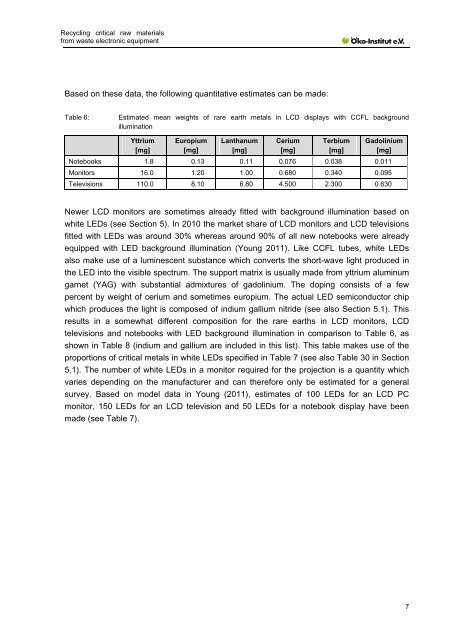Recycling critical raw materials from waste electronic equipment
Recycling critical raw materials from waste electronic equipment
Recycling critical raw materials from waste electronic equipment
You also want an ePaper? Increase the reach of your titles
YUMPU automatically turns print PDFs into web optimized ePapers that Google loves.
<strong>Recycling</strong> <strong>critical</strong> <strong>raw</strong> <strong>materials</strong><br />
<strong>from</strong> <strong>waste</strong> <strong>electronic</strong> <strong>equipment</strong><br />
Based on these data, the following quantitative estimates can be made:<br />
Table 6: Estimated mean weights of rare earth metals in LCD displays with CCFL background<br />
illumination<br />
Yttrium<br />
[mg]<br />
Europium<br />
[mg]<br />
Lanthanum<br />
[mg]<br />
Cerium<br />
[mg]<br />
Terbium<br />
[mg]<br />
Gadolinium<br />
[mg]<br />
Notebooks 1.8 0.13 0.11 0.076 0.038 0.011<br />
Monitors 16.0 1.20 1.00 0.680 0.340 0.095<br />
Televisions 110.0 8.10 6.80 4.500 2.300 0.630<br />
Newer LCD monitors are sometimes already fitted with background illumination based on<br />
white LEDs (see Section 5). In 2010 the market share of LCD monitors and LCD televisions<br />
fitted with LEDs was around 30% whereas around 90% of all new notebooks were already<br />
equipped with LED background illumination (Young 2011). Like CCFL tubes, white LEDs<br />
also make use of a luminescent substance which converts the short-wave light produced in<br />
the LED into the visible spectrum. The support matrix is usually made <strong>from</strong> yttrium aluminum<br />
garnet (YAG) with substantial admixtures of gadolinium. The doping consists of a few<br />
percent by weight of cerium and sometimes europium. The actual LED semiconductor chip<br />
which produces the light is composed of indium gallium nitride (see also Section 5.1). This<br />
results in a somewhat different composition for the rare earths in LCD monitors, LCD<br />
televisions and notebooks with LED background illumination in comparison to Table 6, as<br />
shown in Table 8 (indium and gallium are included in this list). This table makes use of the<br />
proportions of <strong>critical</strong> metals in white LEDs specified in Table 7 (see also Table 30 in Section<br />
5.1). The number of white LEDs in a monitor required for the projection is a quantity which<br />
varies depending on the manufacturer and can therefore only be estimated for a general<br />
survey. Based on model data in Young (2011), estimates of 100 LEDs for an LCD PC<br />
monitor, 150 LEDs for an LCD television and 50 LEDs for a notebook display have been<br />
made (see Table 7).<br />
7

















